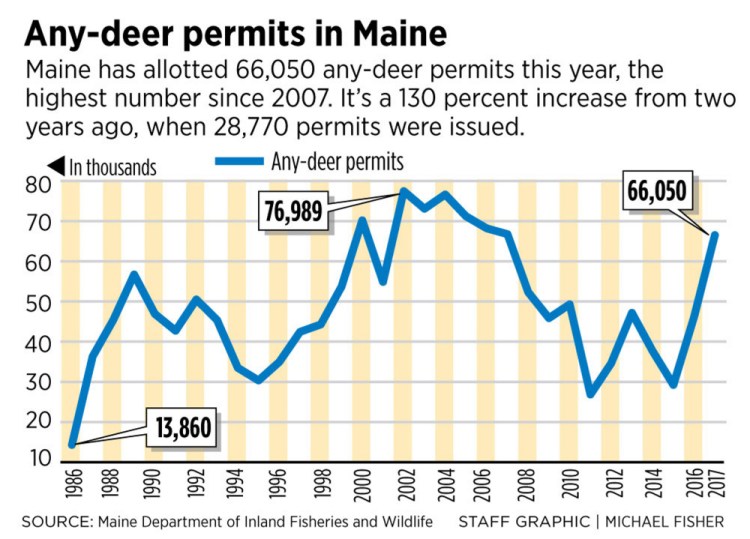State biologists hope hunters can harvest at least 7,000 does this fall in an effort to contain a white-tailed deer population that’s expanded by nearly 20 percent over the past decade.
Maine’s 2017 deer season for firearm hunters begins Saturday and runs through Nov. 25, followed by muzzleloader season, which ends Dec. 2. The state has allotted 66,050 any-deer permits this year, the highest number since 2007. It’s a 130 percent increase from two years ago, when 28,770 permits were issued.
Lee Kantar, a biologist with the Department of Inland Fisheries and Wildlife, said this year’s boost in permits is needed to achieve a desired doe harvest of 7,000. Last year, 5,176 does were harvested after a permit allotment of 45,625; in 2015, 4,486 does were harvested.
Kanter said white-tails can breed at a year old – and it’s common for healthy does to have twins. The severity of winter plays a critical role in the herd’s population.
“The bottom line is we’ve had a series of mild winters,” said Kantar, who served as the state deer biologist from 2005 to 2013. “When you have mild winters, (the deer) population can really take off.”
Wildlife Division Director Judy Camuso estimated that the state’s deer herd at 240,000 this summer. That’s up from an estimated 199,000 in 2008.
The any-deer permit system allows deer hunters to shoot either a doe or a buck. Without one, a hunter can only tag a buck. Many hunters who win an any-deer permit still choose to shoot a buck, Kantar said.
The number of any-deer permits allotted annually has taken some wild swings over the past decade, dropping to a 25-year low of 26,390 in 2011 after harsh winters in 2008 and 2009.
“At the northern end of the white-tail’s range, the response is to how severe the winters have been, or if there have been a couple of mild ones,” Maine deer biologist Nathan Bieber said.
There are more than a dozen factors biologists look at to determine the number of any-deer permits in a given year, including buck kill, the buck-to-doe harvest ratio, antler beam diameter from harvested bucks, road kill, the snow depth, the length of winters, and the winter severity index that takes into account historical data.
Kanter said that during the late 20th century, IFW’s management goal for white-tails – as determined by a public committee – was to “grow deer.” That changed in 2000 when the department limited coastal areas to about 15 deer per square mile because of concerns about Lyme disease, automobile collisions and forest degradation.
The department is currently completing its next 15-year wildlife population plan.
“We’ve heard from the public and they want to see a lid on deer because of ticks,” Kantar said. “The ticks are crazy, even from 10 years ago. And white-tail deer play a role in the life cycle of the deer tick.”
Permits this fall increased dramatically in seven of the state’s 30 hunting districts, primarily in York County and in central Maine up the coast to Belfast.
Hunter Zach McCarthy of Penobscot in Hancock County said the dramatic increase in any-deer permits over the past two years makes sense. McCarthy said the IFW “has a pretty good idea what they’re doing.”
“I looked out my mother’s window yesterday morning at 8 a.m. and there were 10 deer on the lawn, all of them does,” McCarthy said Monday. “I think the population of does increases dramatically on the years they decrease the number of any-deer permits.”
Dayson Cullivan of Palermo, a lifelong hunter who graduated from Unity College with a degree in wildlife management in May, said the IFW’s methods for determining permits is sound.
“I’ve seen the number models,” Cullivan said. “Could it be tweaked here or there? Yeah, probably. But overall, I like it. Winter on deer is one of those things that’s hard to account for. You have to adjust.”
Skyler Gilbert of Brownville doesn’t think the permit increase is needed. Gilbert, 35, said he doesn’t see many deer on his family’s 1,000 acres near Dover-Foxcroft.
“I have two uncles and a dad who put in every year, and they won’t use it, even if they get a (doe) tag,” Gilbert said. “Their line of reasoning is putting in for the any-deer lottery is something they’ve always done, and they want to be able to transfer it to one of the kids if needed.”
Gilbert thinks it would make more sense if Maine’s any-deer system used a doe-only tag, where hunters with a doe permit were required to shoot a doe.
Kantar said this system, used in the moose hunt, would be more of a challenge for deer hunting, because there is a lower success rate in the white-tailed deer hunt and fewer hunters might apply for a doe-only tag.
“With the any-deer permit in place the past 30 years we’ve been able to get a pretty good read on what the (deer) harvest will be,” Kanter said.
Deirdre Fleming can be contacted at 791-6452 or at:
dfleming@pressherald.com
Twitter: FlemingPph
Send questions/comments to the editors.



